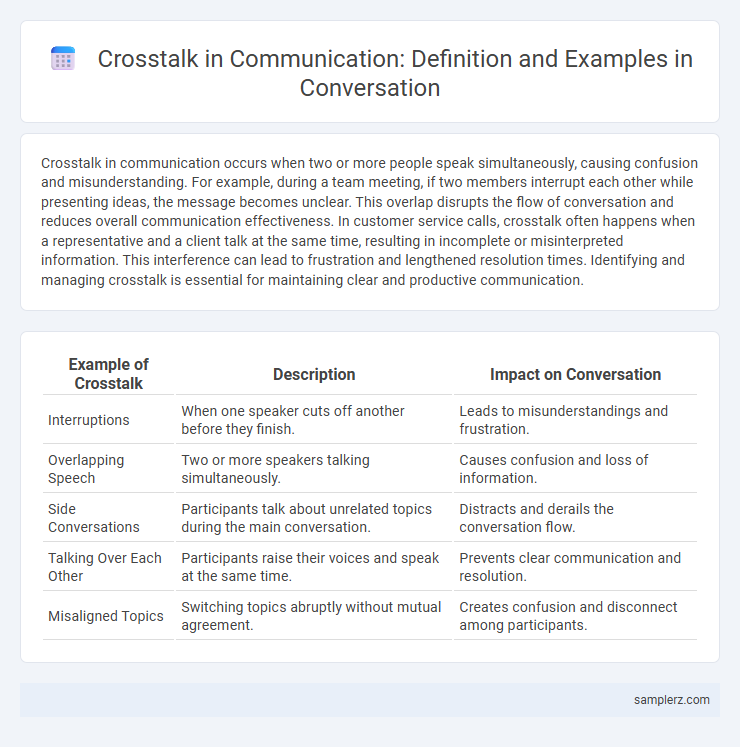Crosstalk in communication occurs when two or more people speak simultaneously, causing confusion and misunderstanding. For example, during a team meeting, if two members interrupt each other while presenting ideas, the message becomes unclear. This overlap disrupts the flow of conversation and reduces overall communication effectiveness. In customer service calls, crosstalk often happens when a representative and a client talk at the same time, resulting in incomplete or misinterpreted information. This interference can lead to frustration and lengthened resolution times. Identifying and managing crosstalk is essential for maintaining clear and productive communication.
Table of Comparison
| Example of Crosstalk | Description | Impact on Conversation |
|---|---|---|
| Interruptions | When one speaker cuts off another before they finish. | Leads to misunderstandings and frustration. |
| Overlapping Speech | Two or more speakers talking simultaneously. | Causes confusion and loss of information. |
| Side Conversations | Participants talk about unrelated topics during the main conversation. | Distracts and derails the conversation flow. |
| Talking Over Each Other | Participants raise their voices and speak at the same time. | Prevents clear communication and resolution. |
| Misaligned Topics | Switching topics abruptly without mutual agreement. | Creates confusion and disconnect among participants. |
Understanding Crosstalk in Everyday Conversations
Crosstalk in everyday conversations occurs when multiple people speak simultaneously, causing overlapping dialogue that hinders clear communication and understanding. This phenomenon often leads to misinterpretations, as key messages become blurred or lost amid interruptions and competing speech. Recognizing crosstalk patterns helps improve active listening and turn-taking strategies to enhance conversational clarity and connection.
Real-Life Examples of Crosstalk During Meetings
Crosstalk during meetings often occurs when multiple participants speak simultaneously, causing confusion and missed information. For example, in a project update meeting, overlapping comments about deadlines and task responsibilities can disrupt the flow and lead to misunderstandings. Effective facilitation techniques, such as taking turns or using a speaker queue, help minimize crosstalk and improve communication clarity.
Crosstalk in Casual Group Discussions
Crosstalk in casual group discussions occurs when multiple participants speak simultaneously, causing overlapping dialogue that disrupts the flow of conversation. This phenomenon often leads to miscommunication as key points may be missed or misunderstood due to competing voices. Effective group communication strategies, such as turn-taking cues and active listening, help minimize crosstalk and enhance clarity in informal settings.
Crosstalk Scenarios in Virtual Communication
Crosstalk in virtual communication often occurs when multiple participants speak simultaneously during video conferences, causing overlapping audio and distorted messages. Common scenarios include team meetings where delayed connections cause speakers to unintentionally talk over one another, resulting in miscommunication or missed information. Effective management tools like mute functions and turn-taking protocols help reduce these crosstalk issues in remote collaboration environments.
The Impact of Crosstalk on Effective Listening
Crosstalk occurs when multiple participants speak simultaneously during a conversation, causing overlapping dialogue that disrupts message clarity and comprehension. This interference significantly impairs effective listening by fragmenting attention and increasing cognitive load, leading to misunderstandings and reduced information retention. Research in communication studies confirms that minimizing crosstalk enhances listener engagement and improves overall conversational effectiveness.
Crosstalk Examples in Cross-Cultural Conversations
Crosstalk in cross-cultural conversations often occurs when participants misinterpret idiomatic expressions or nonverbal cues, leading to overlapping dialogue and confusion. For example, a direct communication style in Western cultures might clash with the indirect approach favored in East Asian cultures, causing interruptions as each party tries to clarify or correct misunderstandings. Such misalignments highlight the importance of cultural awareness to minimize conversational crosstalk and enhance effective communication.
Crosstalk in Professional Interviews
Crosstalk in professional interviews occurs when multiple participants speak simultaneously, causing interruptions and miscommunication that hinder the interview's flow. This overlap can lead to important questions being missed or answers not fully addressed, affecting the accuracy of candidate evaluations. Managing crosstalk through active listening and structured turn-taking ensures clearer communication and more effective assessment outcomes.
Managing Crosstalk in Family Interactions
Crosstalk in family interactions occurs when multiple members speak simultaneously, leading to misunderstandings and frustration. Managing crosstalk involves establishing clear turn-taking rules and encouraging active listening to ensure everyone's voice is heard. Techniques such as using a talking stick or setting designated speaking times improve communication clarity and foster respect among family members.
Crosstalk During Classroom Discussions
Crosstalk during classroom discussions occurs when multiple students speak simultaneously, causing overlapping dialogue that disrupts the flow of conversation and impedes comprehension. This phenomenon can lead to misunderstandings and reduced engagement as important points may be missed or ignored due to the competing voices. Effective classroom management strategies, such as establishing turn-taking rules and using nonverbal cues, help minimize crosstalk and enhance the clarity of communication.
Preventing and Addressing Crosstalk in Conversations
Crosstalk occurs when multiple participants speak simultaneously, causing confusion and impeding clear communication. Preventing crosstalk involves establishing clear turn-taking rules and using hand signals or digital queue systems in virtual meetings to manage speaker order effectively. Addressing crosstalk requires active listening, politely interrupting to restore order, and summarizing key points to ensure mutual understanding among participants.

example of crosstalk in conversation Infographic
 samplerz.com
samplerz.com